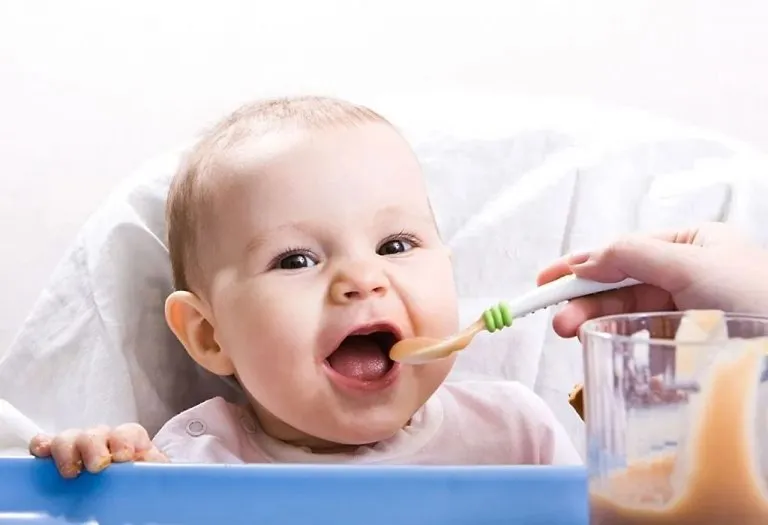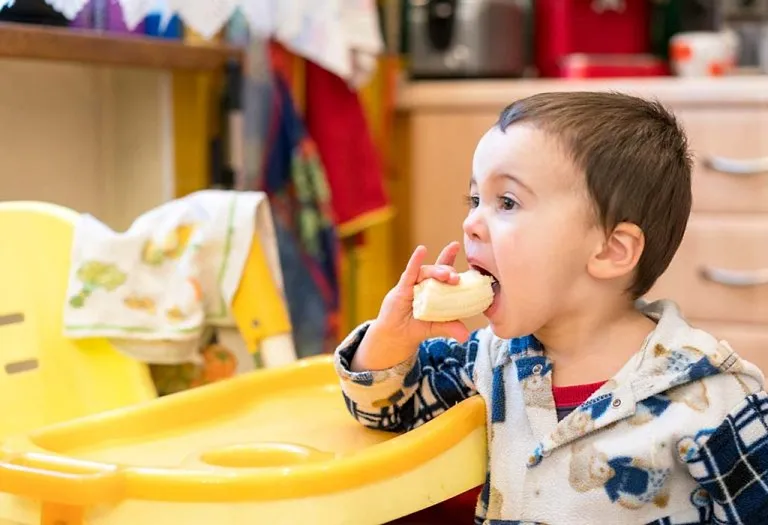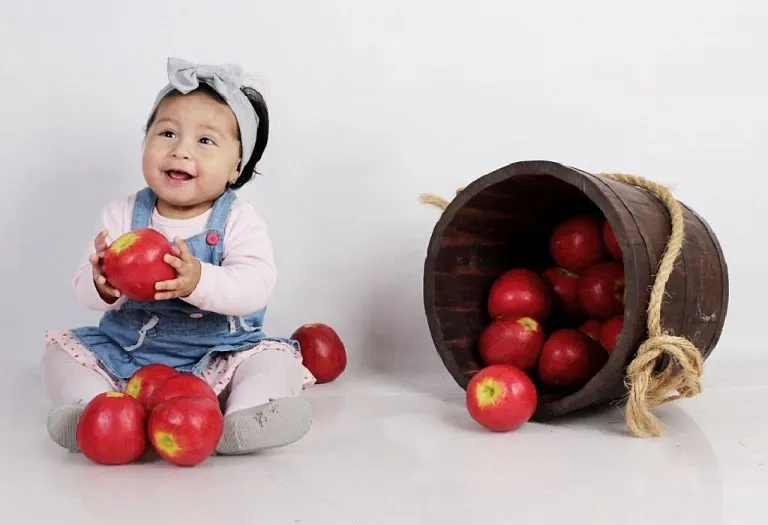Meal Plan/Food Chart for 1 Year Old Baby
- 1 Year Baby Food Chart – Meal Ideas for Your Baby
- Basic Guidelines for Feeding a 12-Month-Old Baby
- FAQs
As soon as your little one reaches toddlerhood, you may encounter a fresh set of challenges that includes feeding him/her. A child at this stage requires nutrients like proteins, vitamins, minerals, carbohydrates, fats and more. However, it is difficult to decide their meals daily to meet the requirements of a balanced diet and keep them healthy. Following a simple diet plan for 1-year-old babies can help you sail through this phase smoothly. In this article, we have tried to provide a sample meal plan and basic guidelines for a 1-year-old/12-month-old baby and a simple and concise 1 year baby food chart that you can print and paste at home for ease.
1 Year Baby Food Chart – Meal Ideas for Your Baby
The meal plan for a one-year-old baby is broken down into weeks to ensure you can include all the nutrition required by your baby in that month. This is a sample 1-year-old meal plan, and you can make changes to it as per the availability of the ingredients and your convenience. You should try to include a variety of foods in your 1-year-old’s diet to develop his taste and to ensure that he eats everything that’s served on his plate. You need not follow a fixed meal plan for him; incorporate whatever you cook for yourself in his daily diet. Just remember to keep the menu light so that your baby can digest the food easily. So, without any further delay, let’s take a look at 12-month-old meal ideas:
1. First week
| Breakfast |
|
| Mid-Morning snack |
|
| Lunch |
|
| Evening Snacks |
|
| Dinner |
|
2. Second Week
| Breakfast |
|
| Mid-morning snack |
|
| Lunch |
|
| Evening Snacks |
|
| Dinner |
|
3. Third week
| Breakfast |
|
| Mid-Morning snack |
|
| Lunch |
|
| Evening Snacks |
|
| Dinner |
|
4. Fourth week
| Breakfast |
|
| Mid-morning snack |
|
| Lunch |
|
| Evening Snacks |
|
| Dinner |
|
Since a lot of the dishes or healthy meals for 1-year-olds mentioned above will be introduced to the baby for the first time, he may resist them for their taste or texture. However, parents can make the transition easy for their babies by following the guidelines given below.
Basic Guidelines for Feeding a 12-Month-Old Baby
By the time children turn one, their bodies can digest almost everything adults eat. You may have noticed that your child is eating less than before, and that’s perfectly normal at this stage. According to the American Academy of Pediatrics (AAP), children at this age should be getting about 1000 to 1400 calories a day. Here are some basic guidelines for you to follow while feeding your year-old baby (1) (2).
- The World Health Organization recommends continuing breastfeeding until your child is 2 years old (3).
- Discuss any family history of food allergies with the paediatrician before you introduce any new food to your child.
- Do not force feed because toddlers generally eat when they are hungry and have no medical condition that affects their appetite.
- Don’t give liquids like milk or juices before mealtime. Limit breastfeeding to a maximum of 32 ounces so that your baby has enough room for solids.
- Babies may hesitate in trying new foods. Don’t give up! Keep offering till the time your child accepts it.
- If your baby is still not used to solid foods, mash it lightly after cooking. Mashing the food also prevents choking hazards.
- Avoid adding spices to your baby’s meals. Keep the meals simple for your baby to get used to the natural taste of the foods.
- Control but do not restrict fatty food items, as fats are necessary for your baby’s health. They provide half the calories your baby needs at his/her age.
- While feeding your little one, ensure the food is it the Goldilocks zone, not too hot and not too cold. This will aid digestion and prevent mouthburns.
- Do not replace any meal with milk, and if your child does not accept it, wait for some time and give solids again.
- If your little one is unable to digest cow’s milk, you can feed him fortified and unsweetened soy milk or fortified almond milk after consulting your paediatrician (4).
- Avoid soft drinks, junk food, and ultra processed foods like soda, cakes, crisps, and cookies.
FAQs
1. What are some tips to help feed 1-year-old babies?
Here are some tips you can follow (2).
- Remember, your little one’s diet and moods are changing in seconds. Therefore, if one day they finish one bowl of porridge and another, they don’t; don’t worry, it’s normal.
- Give your little one plenty of love during their meal time. While feeding, smile and play with them to make mealtime fun and strengthen the bond.
- Continue offering balanced meals and snacks that have healthy fats, proteins, carbohydrates, and antioxidants.
- Your little one now needs whole milk to build at a steady rate. Feed him whole milk, whole milk yogurt, cheese, paneer, or fortified soy milk.
- Do not include sugar or sodium in their diet yet, or keep it to a minimum. Use natural sugars in fruits and dates to sweeten their meal, but don’t add jaggery or sugar to their food yet.
- UNICEF also suggests that you let your child touch and feel the food own in own as well. Give him time to feel the texture and taste of the food when you feed him.
2. What healthy fats and unhealthy fats should I beware of?
As per the American Academy of Pediatrics, you can find healthy fats in dairy and dairy products, olive oil, avocado, and nut butter. Unhealthy fats, on the other hand, are present in fried and deep-fried foods, fast foods, and several packaged items (5). Remember to consult your paediatrician about when and how to introduce healthy fats in your little one’s diet.
The diet chart above is a basic meal plan consisting of all the foods that will provide your one-year-old baby with the nutrition he requires. You would have introduced some foods already, while some will be new. Your little one might take time to get used to the new foods, so be patient and keep trying without force-feeding him/her. By sticking to natural foods and staying away from processed and ultra-processed foods, you’ll easily make the healthiest and best meal for your 1-year-old baby.
References/Resources:
1. Feeding & Nutrition Tips: Your 1-Year-Old; American Academy of Pediatrics; https://www.healthychildren.org/English/ages-stages/toddler/nutrition/Pages/Feeding-and-Nutrition-Your-One-Year-Old.aspx
2. Feeding your baby: 1–2 years; UNICEF; https://www.unicef.org/parenting/food-nutrition/feeding-your-baby-1-2-years
3. Breastfeeding – deciding when to stop; BetterHealth Channel; https://www.betterhealth.vic.gov.au/health/healthyliving/breastfeeding-deciding-when-to-stop
4. Feeding Your 1- to 2-Year-Old; Nemours KidsHealth; https://kidshealth.org/en/parents/feed12yr.html
5. Sample Menu for a 1-Year-Old Child; American Academy of Pediatrics; https://www.healthychildren.org/English/ages-stages/baby/feeding-nutrition/Pages/Sample-One-Day-Menu-for-a-One-Year-Old.aspx
Also Read:
Food Ideas for 1 Year Old Babies
1 Year Old Baby Feeding Schedule, Recipes And Tips
Was This Article Helpful?
Parenting is a huge responsibility, for you as a caregiver, but also for us as a parenting content platform. We understand that and take our responsibility of creating credible content seriously. FirstCry Parenting articles are written and published only after extensive research using factually sound references to deliver quality content that is accurate, validated by experts, and completely reliable. To understand how we go about creating content that is credible, read our editorial policy here.























